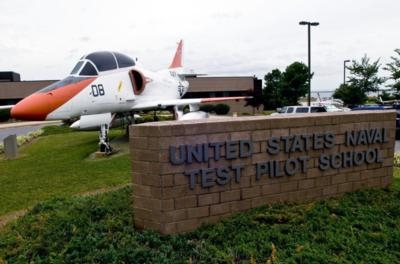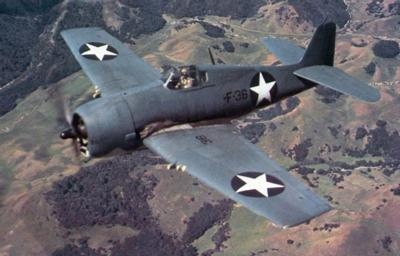School Has Trained 87 U.S. Astronauts
More than 300 staff, students and graduate "Testers" of U.S. Naval Test Pilot School (USNTPS) celebrated 70 years since the school was established at Naval Air Station (NAS) Patuxent River March 12.

One of four major test pilot schools in the world, USNTPS has trained many distinguished Navy, Marine Corps, Army, Air Force and international aviators and engineers, including 87 U.S. astronauts.
"TPS is a tight-knit community that is always there for each other," said Army Lt. Col. Gregory Fortier, commanding officer of USNTPS. "The community always comes together to serve, to work the problems and deliver solutions. Look no further than to the men and women in this hangar today."
"This school has a rich tradition and a very bright future," added Fortier. "May we continue to draw upon the energy in this hangar to propel ourselves into the next phase of producing mission-relevant Testers."
It all started in 1943 when the Navy's flight test group, located at NAS Anacostia, Maryland, transferred to the newly-established NAS Patuxent River.
Test Pilot School evolved from an urgent necessity recognized by Cmdr. Charles Thomas Booth, who got the ball rolling in 1944 after Cmdr. Sydney S. Sherby earned his graduate degree from the Massachusetts Institute of Technology and first reported to Pax River to fill a new billet - chief project engineer.
Booth, flight test officer at the then-Naval Air Test Center (NATC) Patuxent River, tasked Sherby with the job of getting to know the people and become familiar with how they were going about testing at that time. Sherby was given permission to do whatever was necessary to improve the process.
Early in January 1945, after months of studying the issue and numerous visits to Langley Field Laboratory, it was determined that if flight test was to continue to perform its mission effectively and keep pace with progress in aeronautics, the establishment of some formal program of education for test pilots and engineers would be essential. Cmdr. C.E. Giese, who by then had relieved Booth as flight test officer, agreed.
On Feb. 21, Giese appointed Sherby to head a committee of three officers and report back to him in seven days with recommendations. As a result of the extensive work Sherby had been doing, his proposal for an indoctrination course for Navy flight test pilots was ready for review by March 1.
The plan described the outline of the program. The curriculum would cover the fundamentals of aerodynamics, procedures for aircraft performance testing, evaluation of aircraft stability and control characteristics, miscellaneous tests and trials, actual in-flight performance testing and flight test reporting in a standardized format. It was scheduled to fit into 37 hours of classroom work, with nine hours of flight time spread over 10 weeks, meeting Monday, Wednesday and Friday mornings.
Giese approved Sherby's recommendations and appointed him as officer in charge of the flight test pilots training program. Sherby provided the classroom instruction while Lt. H.E. McNeely served as flight instructor.

The first aircraft used for training purposes were the F6F, FM-2, SBD, TBM and SNJ, which were borrowed from the flight test group on base.
The first class, consisting of 14 pilots and engineers, later designated as Class 0A, began March 12, 1945 and graduated May 30. NATC Commander Capt. A.D. Storrs gave each student a diploma and a slide rule for their accomplishment. Class 0B convened in October that year, but the enrollment was diversified. It included students from other NATC activities.
In March 1946, newly-appointed commanding officer of the NATC, Capt. J.D. Barner wrote to the chief of the Bureau of Aeronautics stating the need for a formal test pilot school, suggesting it be established as a division of NATC. Barner recommended semi-annual classes of about 30 students with a duration of four to five months.
About the time Class 0C was in school in 1946, Capt. Frederick M. Trapnell, the man for which Pax River's air field is named, was ordered to the installation as the commanding officer of NATC. Trapnell had previously served as flight test officer when the flight test group was in Anacostia. His love and interest in test flying proved invaluable to the development for a formal naval test pilot school.
Trapnell sat in on Sherby's classes, and while he was impressed, it became clear to him that the training program being taught was inadequate, and he requested authorization and funding to establish a full-time course of about 30 students, with classes convening every nine months. His suggestion came from the detailed recommendations submitted by Giese.
The cost for the school's first year was estimated at $25,000. Then-Chief of Naval Operations (CNO) Fleet Adm. Chester W. Nimitz agreed to the request, and Trapnell began drafting a final blueprint for the school. Trapnell submitted the final draft to the office of the CNO on Oct. 20, 1947.
On Jan. 22, 1948, Trapnell's plan for a formal test pilot school being a division of the NATC was approved by Adm J.D. Price, deputy chief of Naval Operations. Sherby was relieved of his duties as chief project engineer in the flight test division to assume his new duties as director of the test pilot training division.
In 1957, the school's name was formally changed to the U.S. Naval Test Pilot School. It was listed in the Bureau of Naval Personnel's Catalog of Naval Schools and was included in the officer special qualifications listed in the Naval Register.
Courses were continuously being revised to accommodate new technology which brought about faster and more sophisticated aircraft. As time went on, courses became more complex. The curriculum now accommodates three different criteria: fixed-wing, rotary-wing and airborne systems.
The school moved four different times during its history until their present academic facility, building 2168, was built in 1993.
USNTPS is the only test pilot school in the U.S. military that offers academic courses on helicopters, and the only one in the world for airborne systems. USNTPS has trained well-known aviators including many of the early astronauts who helped launch the U.S. space program.
Today, USNTPS provides instruction to Navy, Marine Corps, Army and Air Force aviators, international aviators/engineers, and civil service engineers. Accepting 36 students at a time for courses lasting approximately 48 weeks, a class convenes each February and August.
Graduating students use their expertise in the acquisition community, working on aircraft and weapons systems, performing flight tests and managing the introduction of new assets to the fleet.
(U.S. Navy Image)
 ANN's Daily Aero-Linx (04.13.24)
ANN's Daily Aero-Linx (04.13.24) ANN's Daily Aero-Term (04.13.24): Beyond Visual Line Of Sight (BVLOS)
ANN's Daily Aero-Term (04.13.24): Beyond Visual Line Of Sight (BVLOS) Airborne 04.09.24: SnF24!, Piper-DeltaHawk!, Fisher Update, Junkers
Airborne 04.09.24: SnF24!, Piper-DeltaHawk!, Fisher Update, Junkers Aero-News: Quote of the Day (04.14.24)
Aero-News: Quote of the Day (04.14.24) ANN's Daily Aero-Term (04.14.24): Maximum Authorized Altitude
ANN's Daily Aero-Term (04.14.24): Maximum Authorized Altitude




